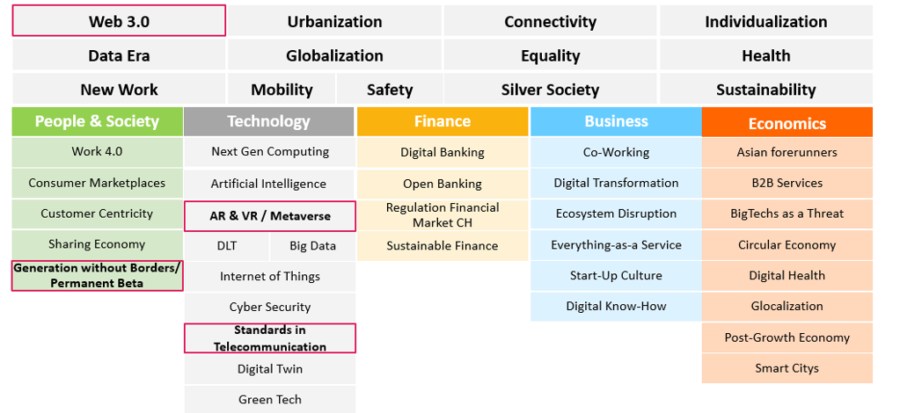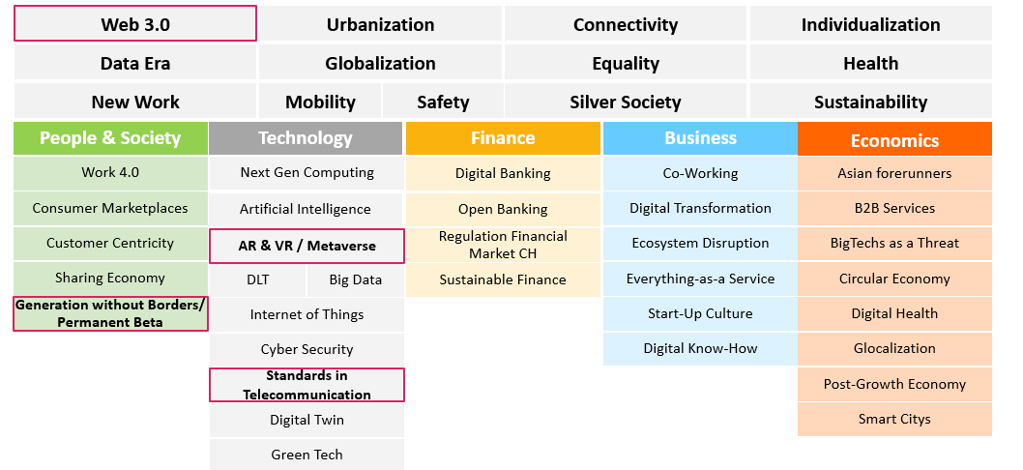
Trend Impact Radar 2023: New Trends for the Financial Industry
Part 1: Mega and macro trends
Business is in a permanent state of flux: global warming and finite resource supplies require a greater focus on sustainability; technologies are evolving and enabling new services and forms of collaboration; new generations of customers are coming of age and challenging companies to adapt their offerings to new needs. This is just a small selection of the issues impacting the operations of companies.
The Competence Center Ecosystems regularly identifies and analyzes the most important trends impacting financial institutions and financial-related service providers. In doing so, we look at the development of megatrends, macrotrends and microtrends as well as their impact on the financial industry. By megatrend, we mean trends that will take more than ten years to establish themselves in the financial industry. Macrotrends can take hold within five to ten years. The term microtrends refers to more short-term developments or use cases.
The last update to the Trend Radar on our blog was from September 2020, when I wrote about the impact of the Corona pandemic. A lot has happened since then. Today, I’d like to share the four mega- and macro-trends that we’ve classified as relevant to the financial industry as part of our latest internal update.

Web 3.0
Whereas Web 1.0 served the broad masses merely to consume or download data, Web 2.0 enabled users to make data available to others (download and upload) even without much prior technical knowledge. This enabled the realization of completely new business models. BigTechs like Facebook, TikTok or Instagram, but also AirBnb or Uber would be inconceivable without user-created content. Likewise, without the ability to generate their own content, there would be no influencers, at least not on today’s scale: the marketing budget spent on influencers worldwide rose from $6.04 billion in 2017 to almost $28 billion in 2022 [2]. BigTechs’ behavioral tracking also benefits from user-generated content, as it provides algorithms with the information they need to tailor advertising even more specifically to the customers of their services. The contours of Web 3.0 are now beginning to emerge. Based on our research into increasing data sovereignty by the customer and the further development of DLT-based business models, we assume that Web 3.0 will be characterized by the theme of ownership in addition to downloading and uploading. This means that users will be able to own or manage their own data and identities. At the same time, tokenized assets – virtual or real assets whose ownership and/or usage rights are mapped in the form of a token on a blockchain – can be owned, traded and transferred. The possibility of “owning” digital content opens up the possibility of developing new business models, analogous to Web 2.0. Not only will existing services in the financial industry be raised to a new level (switching from fiat to cryptocurrencies, managing tokenized assets, etc.), but new services will also emerge that are as yet unknown to us [a].
AR & VR / Metaverse
As a reminder, the metaverse is “a virtual space where users move around with the help of avatars and where they can influence and use virtual artifacts, such as when they put on clothes, build a house and furnish it, open a door and step out into the street to meet fellow players and like-minded people. Just like in the real world, people can live, work, learn, trade, have conversations, and build relationships there” [3]. Augmented reality (AR) and virtual reality (VR) are closely related to the development of the metaverse, as they help simulate a real-life experience, for example, by holding meetings in a virtual environment using VR goggles and avatars. For this reason, we counted these three topics as a related trend. Experts disagree on how quickly metaverses will take hold and whether this is a mega or macro trend. For more information, see the blog post “Race for the Pole Position in the Metaverse – Business Opportunities for Banks”.
Generation without Borders / Permanent Beta
The Generation without Borders, also known as Generation Z and comprising those born between around 1998 and 2016, is likely to be self-employed in the future or employed in several jobs at the same time. Its members anticipate a high degree of financial insecurity and tend to be pessimistic in their future planning with regard to purchasing real estate or drawing a pension. On the other hand, they are constantly exposed to information like no generation before [b]. They have access to real-time information worldwide (we’ll leave the issue of fake news aside here) and are thus able to compare themselves on a permanent basis. Their consumption is changing and becoming more conscious. Issues such as mental health and well-being as well as climate change and sustainability are becoming increasingly important , as are gender neutrality and inclusivity [c]. This is also reflected in the expectations placed on companies, which we will examine in more detail in the second part of this article under the heading of “corporate responsibility”. Permanent beta as a term actually comes from the software industry and refers to software that has not yet reached the final state of its development. But it is also true for people that they are never “finished” but must continue to develop and learn throughout their lives [d] if they want to keep up in working life [4].
Standards in Telecommunications
There are a number of outstanding technologies and trends in the telecommunications sector that are increasingly being used to improve the customer experience, network and business resilience, and value propositions. 5G services offer companies the opportunity to offer new services due to their transmission speed and security. For example, surgeries can be performed today where the ordering physician is not present in the operating room. In this case, he or she can place markers for the operating physician’s next steps on images transmitted in real time or even operate instruments directly [5]. 6G can enable communication with a latency of one microsecond. In addition, non-terrestrial networks (NTNs) such as unmanned aerial vehicles (UAVs) and satellites can now be controlled. Again, new services will emerge driven by this technology [6].
Impact Analysis Based on Macro Trends
For each of the macro trends listed in the trend map above, CC Ecosystems has a one-page description that captures the respective definition of the macro trend, a more detailed description, and the associated micro trends. The “maturity level” of the trends is determined indicatively by mapping in the Gartner Hype Cycle as well as on the basis of the number of Google searches for that particular topic. At the same time, the document also contains an assessment of how strongly each trend impacts the enterprise and ecosystem level.
The impact of all these weighted trends is analyzed in the next step. What is the impact of the trends at the company level in the areas of customer, business model, market, process, system, and service offering, and at the business ecosystems level in the areas of participants, business ecosystems model, and process? Hypotheses on the impact of the trends are formulated for each of these areas; these can then be individually adapted for the bank in question.

For example, in the dimension “customer segmentations” dimension (customer area), we assume that familiar customer segmentations will dissolve (Segment of One). Among other things, this can be attributed to the fact that the individualization of the Generation without Borders has progressed so far that traditional segmentation criteria are losing their value. This development implicitly requires a modularization of services (and implicitly processes). These formulated hypotheses are used for a targeted discussion of the impact of current developments on the positioning of banks and can also be used, among other things, to challenge one’s own strategy.
Part 2 of this blog post will deal with an excerpt of currently observable micro trends and their classification. So check back in two weeks or follow us on LinkedIn to make sure you don’t miss a thing.
[a] You can read more about Web 3.0 in Benjamin Schaefer’s blog post “Web3 and DAOs – the next hype?“. [b] What technostress is and how companies can reduce this stress for their employees is explained by Katharina Schache in “Technostress – The Dark Side of the Increasing Use of Information and Communication Technologies“. [c] Joël Eugster discusses how companies can support them in the blog post “Shortage of Skilled Workers in Switzerland“.
